2 1/4 by William Eggleston [Column_Printed Matter]
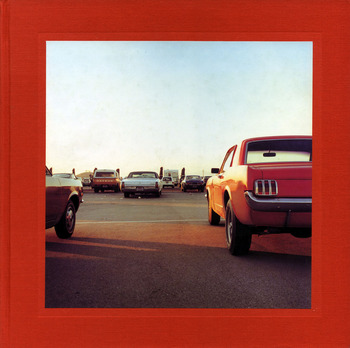 : cover
: cover2 1/4 by William Eggleston, 101 pages, Twin Palms Publishers, 1999
William Eggleston is another master of 70’s color photography besides Stephen Shore, Joel Sternfeld and Joel meyerowitz. This book represents Eggleston’s classic images taken between 1966 and 1971, in Mississippi and Tennessee.
While Stephen Shore captures the whole 70’s suburban landscape, William Eggleston rather clips details from it. The object he clips is a car, a billboard, a cafe or power lines at time. These objects he clips appear to us as “sad and joyful and indifferent” images, according to Bruce Wagner.
Effectiveness of faded suburban details may be not what we should read primarily from his photos. I think we should rather eye the way he clips: unique close-ups captured from medium/low angles and in square frames. I think there is a distinctive relation, so to say, a fond detachment between Eggleston and things he captures.
Incidentally, our models and layouts used to be captured from high angle. Athearn and Atlas capture their products from high angle showing their roofs. Kato and MTL capture from medium heights: roofs are barely shown. Legendary Model Railroader Magazine seems prefer high angle photos for the cover photo. To the contrary, fresh Model Railroad Hobbyist Magazine seems prefer medium/low angle shots.
Thus, the heights of the angle of model photos differ according to purposes and/or tastes, and are seem becoming progressively lower. Off course, specifications of recent cameras would contribute to it. But, I think the change of relation between us and the models also act on it.
High angle is said to be the angle of the transcendency. To the contrary, medium angle is said to be the angle of citizen. We are not the transcendencies, but only a modeler today. Thus, medium angle would be appropriate for us. Accordingly, a hint for improving our model photo value might have hidden in the margin between the two, our photo and William Eggleston’s medium/low angle photo.
some of the photos in this monograph can be seen here;
2014-03-14 09:00
コメント(0)
The Model Railroader’s Guide to Freight Cars by Jeff Wilson [Column_Printed Matter]
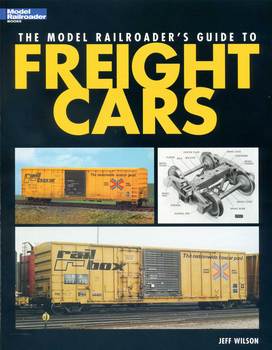 : cover
: coverThe Model Railroader’s Guide to Freight Cars by Jeff Wilson, 96 pages, Kalmbach Publishing Co., 2005
This book provides brief histories of each type of Freight car development starting from USRA standard designs to the present, using many pictures. Types of car are shown as the index below. Tracks and brake systems are also explained in a chapter. Still more provided are the columns explaining details such as letterings, boxcar doors, ends and roofs.
Accordingly, we can identify the type of a particular rolling stock which we are going to model. From the point of view of the thinness of this book, I think it is magnificent.
The contents are:
04: Introduction
05: Boxcars
21: Tank Cars
32: Covered Hoppers
43: Refrigerator Cars
51: Hoppers and Gondolas
63: Flat Cars
71: Intermodal Equipment
79: Car Components
89: Appendix
2014-08-01 09:00
コメント(0)
Denver & Rio Grande Western Depots by Clive & David Carter [Column_Printed Matter]
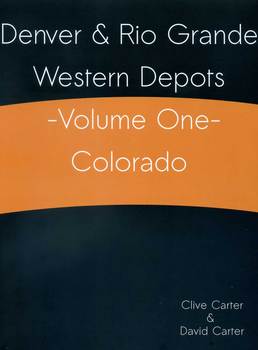
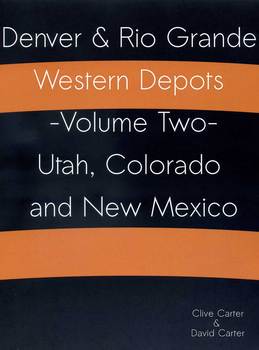 : cover
: coverI came to find these books at Amazon while I was looking for the picture of Cisco depot.
“Denver & Rio Grande Western Depots Vol. 1, Colorado” by Clive & David Carter, 156 pages, Createspace, 2013
“Denver & Rio Grande Western Depots Vol. 2, Utah, Colorado and New Mexico” by Clive & David Carter, 158 pages, Createspace, 2013
These books cover all the Rio Grande depots in Colorado, Utah and New Mexico. Vol. 1 features depots of standard gauge Rio Grande line depots in Colorado. Vol. 2 features standard gauge Rio Grande line depots in Utah and narrow gauge line depots. Vol. 3 features other railroads’ depots in Colorado.
Carters collected the documents from Interstate Commerce Commission (ICC) survey records, valuation update reports by the railroad and other company records.
Basically, each page has basic information of a depot: site altitude, built date, overall dimensions, material, moved/destroyed/retired date and the drawings from ICC records.
Carters also added plat maps and photos to most of (unfortunately not all) the depots. These will help us modeling accurate structures.
Here are the contents;
VOL. 1
004: Introduction
005: Overland Park to Salida
048: Brown Canon to Grand Jct.
080: Minnequa to Trinidad
096: Poncha Junction to Gunnison
106: Kezar to Whitewater
119: Villagrove to Alamosa
127: La Veta to Blanca
133: Branch Lines
154: Acknowledgements
155: Index
VOL. 2
003: Introduction
004: Monte Vista to Creede
010: Tres Piedras to Santa Fe
018: La Jara to Chama
027: Monero to Durango
040: Trimble to Silverton
046: Farmington & Other Lines
052: Utah Lines
091: Utah Branch Lines
125: Denver & Salt Lake
148: Rio Grande Southern
155: Acknowledgements
156: Index
2015-06-13 09:00
コメント(0)
Rio Grande in Color Volume 2: Utah by James Sandrin [Column_Printed Matter]
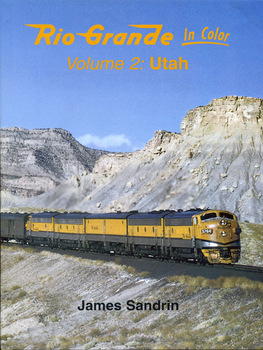 : cover
: cover“Rio Grande in Color Volume 2: Utah” by James Sandrin, 128 pages, Morning Sun Books, 1998
This book introduces Rio Grande Utah Lines westward starting with Grand Junction. Era concerned dates from transition era and ends up with the second generation diesels era.
I think color photos of Thistle, Marysvale Branch and Eureka Branch are rare and valuable. I owe my “Rio Grande Remnants in Utah” columns to this book.
Reading it along with the book Rio Grande Secret Places Volume 2 may well help understanding of the Rio Grande's Utah Lines.
Here are the contents;
006: Grand Junction
015: Grand Junction Switchers
017: The line to Montrose
019: The Somerset Branch
022: Fruita
023: Ruby Canyon
025: Sagers
025: Thompson
028: Brendel
030: Solitude
030: Green River
032: Desert
034: Grassy
035: mounds
037: The Sunnyside Branch
039: Price
042: Helper
046: Helper’s Special Duty Units
049: Price River Canyon
065: Soldier Summit
070: Gillury
076: Narrows
079: Thistle
081: Marysvale Branch
087: Spanish Fork Canyon
094: Jordan River Valley
096: Springville
096: Eureka Branch
100: Provo
104: Geneva
106: Welby
107: Murray
107: Roper
111: Salt Lake City Switchers
114: Salt Lake City
2015-11-14 09:00
コメント(0)
Hopper by Rolf G. Renner [Column_Printed Matter]
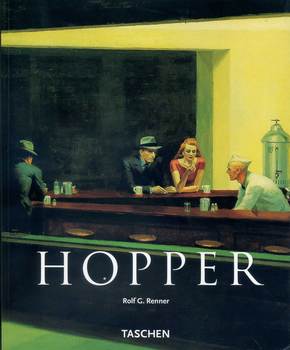 : cover
: coverHopper by Rolf G. Renner, 96 pages, Taschen, 2002
Figurative painters select what to paint. There is a selection of the subject in a painting. The selection depends not on their technique but on their philosophies for art. Even the rivet counters have to select what to make and what to give up when modeling. That is, we also have to establish a philosophy for modeling.
But establishing a philosophy is difficult because the first principle of our hobby is not to agonize but to have fun, I think. That is to say, borrowing it might be the shortest way. Thus, I referred to artists’ philosophies in duplicating the whole town of Cisco Utah in N scale. One is of Stephen Shore, and the other is of Edward Hopper.
Edward Hopper(1882 - 1967) is a well known "New Realism" painter. His Painting is not rich in details, but it definitely duplicates the scene he caught. I thought his method is useful in N scale modeling. His way of portraying the light, either sun or electric, might be the key to success.
This book gives an outline of Hopper’s paintings. Many paintings are represented in color. Most of his paintings portray the East. Many railroad oriented paintings like New York, New Haven and Hartford, House by the Railroad, Railroad Crossing, Railroad Sunset and so forth are compiled in this book.
Here are the contents;
06 European Beginnings
20 Pictures of the New World
30 The Frontier of Civilization
44 Man and Nature
64 Self and Other
84 Transformations of the Real: Hopper as Modernist
94 Edward Hopper 1882-1967: A Chronology
96 Notes
2016-02-12 09:00
コメント(0)
Rio Grande series by Ronald C. Hill [Column_Printed Matter]
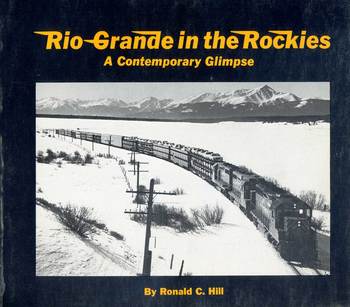
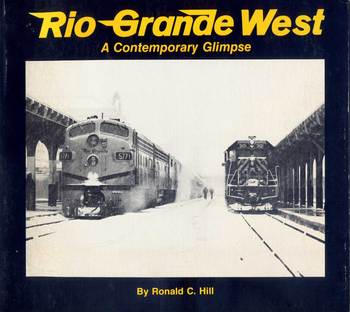
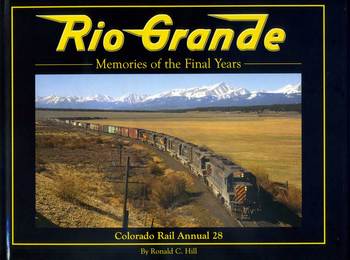 : covers
: coversRio Grande in the Rockies – A Contemporary Glimpse by Ronald C. Hill, 80 pages, Colorado Railroad Museum, 1977
Rio Grande West - A Contemporary Glimpse by Ronald C. Hill, 80 pages, Colorado Railroad Museum, 1982
Rio Grande – Memories of the Final Years by Ronald C. Hill, 112 pages, Colorado Railroad Museum, 2007
Author Ronald C. Hill(1937 - 2023) was a lawyer in Denver and was the president of the Colorado Railroad Museum between 1981 and 1994.
These books mainly feature the 70s and 80s Rio Grande standard gauge activities in Colorado. One photo in a page is the basic throughout these three books. Accordingly, we can enjoy large and crisp images captured by Ron’s Leica, Nikon, Rolleiflex, and Hasselblad: the first two books represent black and white photos, while the last represents color photos. Belief explanation including place/date is added to each image.
Ron captured the trains at the same points for decades: see two cover images of the first and the third book. Accordingly, we can see the march of time or season and the change of train consist. But the first issue alone would be enough for admiring the Rio Grande standard gauge activities in Colorado.
revised, Feb. 9, 2023
2016-07-29 09:00
コメント(0)
“Paris, Texas” by Wim Wenders [Column_Printed Matter]
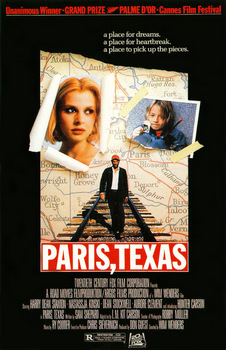
“Paris, Texas”, Road Movies Filmproduktion, Channel Four Films, Argos Films, Westdetscher Rundfunk, 150 minutes, 1984
Directed by Wim Wenders
Written by L. M. Kit Carson and Sam Shepard
Starring Harry Dean Stanton, Nastassja Kinski
Here is another movie starring trains shot in the “nearly” '70s.
In this movie, we can see westbound SP double-stack train led by three EMD tunnel motors runs through Marathon, Texas. As the scene was shot in 1984, it shows the very early days of double stacking.
Marathon Motel at the namesake town and El Rancho Motel at Fort Stockton, both in Texas, featured in this movie are my favorite, too. Both motels still exist and in business to this day. When we visited, the town of Fort Stockton was basking in the afterglow of the shale oil boom.
El Rancho Motel, Budget Inn today, can be seen next to the Shell station in my photo below. Closed gas service station found next to the Shell station is also featured in the movie. This side of our motel, Deluxe Inn, was the only prosperity on East Dickinson Boulevard named XXX Lucky Bonita.
* “Paris, Texas” trailer;
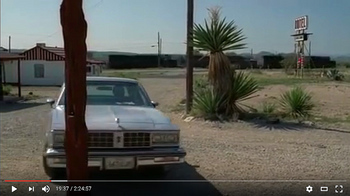 : Marathon Motel, SP train in the background
: Marathon Motel, SP train in the background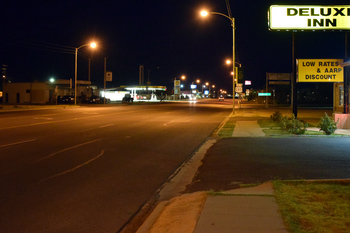 : Sep. 11, 2015. E Dickinson Blvd, Fort Stockton, Texas
: Sep. 11, 2015. E Dickinson Blvd, Fort Stockton, Texas2016-10-21 09:00
コメント(0)
Prototype Lettering Diagrams, Decal Catalog and Lettering Plan Book [Column_Printed Matter]
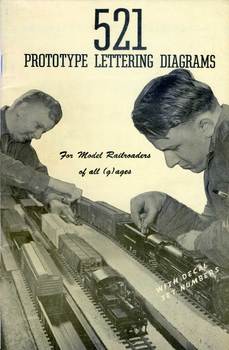
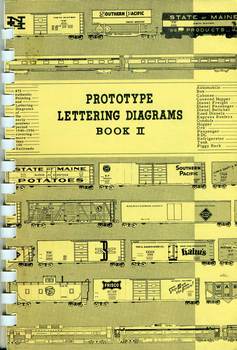
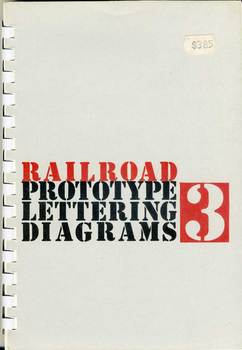
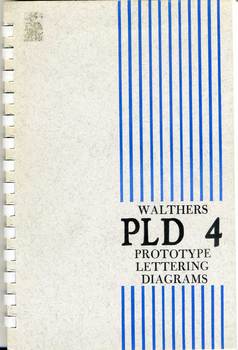
: Prototype Lettering Diagrams covers
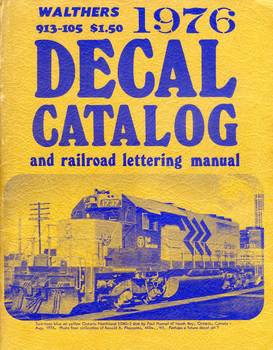 : Walthers 1976 Decal Catalog cover
: Walthers 1976 Decal Catalog cover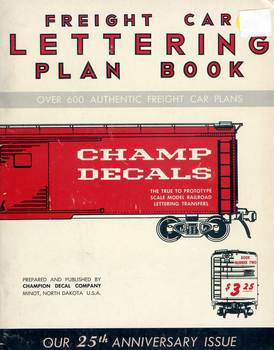 : Freight Car Lettering Plan Book cover
: Freight Car Lettering Plan Book cover521 Prototype Lettering Diagrams by W.K. Walthers, 46 pages, Walthers Inc., 1942, revised 1973
Prototype Lettering Diagrams 2 by W.K. Walthers, 86 pages, Walthers Inc., 1956, revised 1972
Prototype Lettering Diagrams 3 by Wm. K. Walthers, 111 pages, Walthers Inc., 1962, revised 1972
Prototype Lettering Diagrams 4 by W.K. Walthers, 73 pages, Walthers Inc., 1963, revised 1972
Walthers 1976 Decal Catalog and railroad lettering manual, 92 pages, Walthers Inc., 1976
Freight Car Lettering Plan Book, 80 pages, Champion Decal Co., 1965
To find a particular boxcar red boxcar for my next “Paint Shop” project, books like Morning Sun Color Guide(MSCG) and web sites like Fallen Flags or RR Picture Archives are the great sources. Besides these books and web sites, printed matters represented above also help finding my next project as they represent lettering diagrams of particular cars.
In the foreword of PLD, William K. Walthers(1893 – 1967) writes “diagram is accurate and authentic”. In the foreword of Lettering Plan Book, Richard L. Meyer(1927 – 2003) says “numbers shown on lettering plans are actual”. After comparing with the photograph, I came to trust them: for example, diagram of DRGW #64043 found in Champ catalog is virtually the same as of #64057 from the same #64000-64099 series XM found in MSCG.
Walthers’ PLD-1 illustrates 521 diagrams of the 30’s to the 40’s, “Steam Era” lettering. PLD-2 illustrates 475 diagrams found between 1946 and 1956, “Early Post-war Period” lettering. PLD-3 illustrates more than 600 diagrams found between 1956 and 1962. PLD-4 illustrates diagrams found between 1962 and 1966, and is the latest PLD. 1976 Catalog is fundamentally a list with a few diagrams.
Champ’s Plan Book illustrates 611 diagrams covering 208 railroads and private owners, from steam era to the 60’s.
Anyway, looking thousands of graphic designs itself is a great joy for me: this joy is maybe one of the prime mover of continuing this blog.
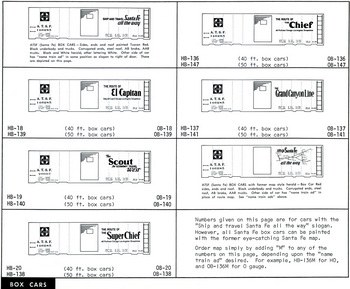 : ATSF page from Freight Car Lettering Plan Book by Champion Decal Co.
: ATSF page from Freight Car Lettering Plan Book by Champion Decal Co.2016-10-28 09:00
コメント(0)
Rio Grande System Telephone Directory [Column_Printed Matter]
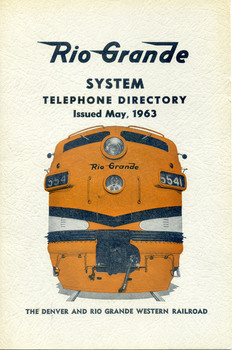
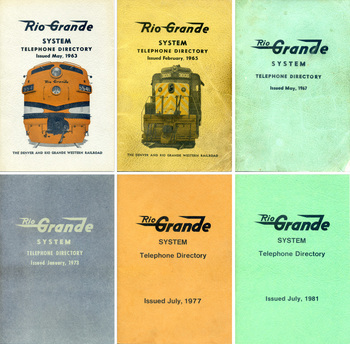
Rio Grande SYSTEM Telephone Directory
Issued May, 1963
Issued February, 1965
Issued May, 1967
Issued January, 1973
Issued July, 1977
Issued July, 1981
These must have been one of the printed matters depots or section houses kept: the Telephone Directories. Directories I have are issued in 1963, 1965, 1967, 1973, 1977 and 1981: if they are issued every two years, 1969, 1971, 1975 and 1979 versions are missing at my collection. Each has Private Branch Telephone Exchange Directory in both alphabetical lists of names and list of departments.
My purpose to collect these was to verify the change over the years of Rio Grande facilities at Cisco, Utah. According to these directories:
In May 1963, Cisco is assigned 144 in List of Waystation Telephones, 77_Grand Junction Helper Line, but already in Seasonal status.
In Feb. 1965, Cisco is disappeared from the Directory.
In Jan. 1973, Cisco is reappeared as CISCO SECTION assigned 147.
In Jul. 1977, Cisco is listed as CISCO SECTION assigned 147.
In Jul. 1981, Cisco is listed as CISCO SECTION - SIGNAL assigned 147.
I knew that the depot was seasonally closed between December 15 and April 15 since 1950[1]. According to D&RGW Depots by Clive and David Carter, the depot was retired in 1965. Therefore, it seems the depot finally closed its doors on Dec. 14, 1964, and demolished soon after that before Feb. 1965.
Further research is needed where the CISCO SECTION phone was installed: Cisco never had a section house.
[1] Feb. 16, 1950 Times-Independent;
2017-09-08 09:00
コメント(0)
Staying Home, part 1 [Column_Printed Matter]
Virtual Railfan Channel at Youtube provides the relieving opportunity even to the overseas enthusiasts like me in Japan these gloomy days.
According to their homepage, Virtual Railfan boasts 79 cams at 48 locations in 23 states[1]. 24 live-streams are available on Youtube and we can watch them free. Among them, my favorite locations are Elkhart, Indiana and Belen, New Mexico only because I’ve been there once.
The cameras at Elkhart, Indiana seem installed on the roof of the National New York Central Railroad Museum. My favorite here is the lit head and marker lights of the NYC #3001 you can see on the far left side: as you can see below, it’s quite another thing if the lights are on. I also like to see the local train with caboose as a shoving platform occasionally rolls in front of the camera.
 : Elkhart, IN. Sep. 5, 2019
: Elkhart, IN. Sep. 5, 2019
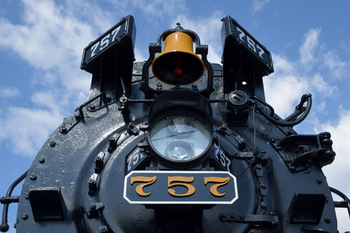 : Bellevue, OH. Sep. 6, 2019
: Bellevue, OH. Sep. 6, 2019
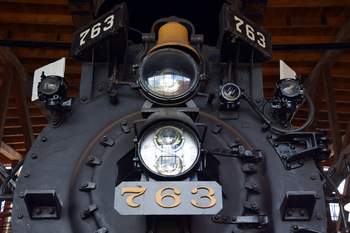 : Sugarcreek, OH. Sep. 7, 2019
: Sugarcreek, OH. Sep. 7, 2019
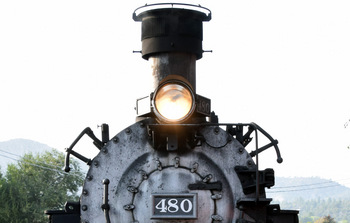 : Durango, CO. Sep. 7, 2017
: Durango, CO. Sep. 7, 2017
Virtual Railfan Grab Bag also at Youtube provides a unique opportunity to catch rare equipment and trains that appeared in the last 24 or 48 hours of streamings edited in several minutes for those who missed them.
[1] Virtual Railfan homepage;
According to their homepage, Virtual Railfan boasts 79 cams at 48 locations in 23 states[1]. 24 live-streams are available on Youtube and we can watch them free. Among them, my favorite locations are Elkhart, Indiana and Belen, New Mexico only because I’ve been there once.
The cameras at Elkhart, Indiana seem installed on the roof of the National New York Central Railroad Museum. My favorite here is the lit head and marker lights of the NYC #3001 you can see on the far left side: as you can see below, it’s quite another thing if the lights are on. I also like to see the local train with caboose as a shoving platform occasionally rolls in front of the camera.
 : Elkhart, IN. Sep. 5, 2019
: Elkhart, IN. Sep. 5, 2019 : Bellevue, OH. Sep. 6, 2019
: Bellevue, OH. Sep. 6, 2019 : Sugarcreek, OH. Sep. 7, 2019
: Sugarcreek, OH. Sep. 7, 2019 : Durango, CO. Sep. 7, 2017
: Durango, CO. Sep. 7, 2017Virtual Railfan Grab Bag also at Youtube provides a unique opportunity to catch rare equipment and trains that appeared in the last 24 or 48 hours of streamings edited in several minutes for those who missed them.
[1] Virtual Railfan homepage;
2020-04-17 09:00
コメント(0)
Staying Home, part 2 [Column_Printed Matter]
Virtual Railfan Channel at Youtube provides the relieving opportunity even to the overseas enthusiasts like me in Japan these gloomy days.
According to their homepage, Virtual Railfan boasts 79 cams at 48 locations in 23 states[1]. 24 live-streams are available on Youtube and we can watch them free. Among them, my favorite locations are Elkhart, Indiana, and Belen, New Mexico only because I’ve been there once.
The camera at Belen, New Mexico is installed on the roof of the Harvey House Museum. My favorite here is to see the departing BNSF trains quickly catching speed after the brief fuel/crew change stop: they attain top speed even their ends aren’t clearing the facilities yet. Loitering switchers retaining Bluebonnet or Cascade Green schemes are also my favorites.
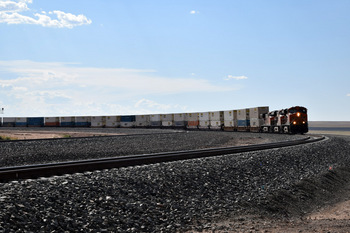 : Vaughn, NM. Sep. 12, 2015
: Vaughn, NM. Sep. 12, 2015
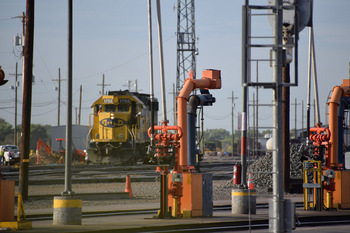 :Belen, NM. Sep. 9, 2015
:Belen, NM. Sep. 9, 2015
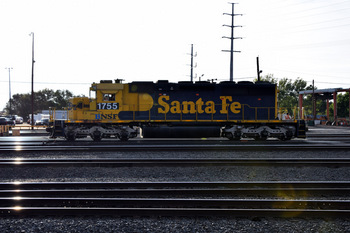 :Belen, NM. Sep. 9, 2015
:Belen, NM. Sep. 9, 2015
Virtual Railfan Grab Bag video also at Youtube provides a unique opportunity to catch rare equipment and trains appeared in the last 24 or 48 hours of streamings edited in several minutes for those who missed them.
[1] Virtual Railfan homepage;
According to their homepage, Virtual Railfan boasts 79 cams at 48 locations in 23 states[1]. 24 live-streams are available on Youtube and we can watch them free. Among them, my favorite locations are Elkhart, Indiana, and Belen, New Mexico only because I’ve been there once.
The camera at Belen, New Mexico is installed on the roof of the Harvey House Museum. My favorite here is to see the departing BNSF trains quickly catching speed after the brief fuel/crew change stop: they attain top speed even their ends aren’t clearing the facilities yet. Loitering switchers retaining Bluebonnet or Cascade Green schemes are also my favorites.
 : Vaughn, NM. Sep. 12, 2015
: Vaughn, NM. Sep. 12, 2015 :Belen, NM. Sep. 9, 2015
:Belen, NM. Sep. 9, 2015 :Belen, NM. Sep. 9, 2015
:Belen, NM. Sep. 9, 2015Virtual Railfan Grab Bag video also at Youtube provides a unique opportunity to catch rare equipment and trains appeared in the last 24 or 48 hours of streamings edited in several minutes for those who missed them.
[1] Virtual Railfan homepage;
2020-04-24 09:00
コメント(0)
Staying Home, part 3 [Column_Printed Matter]
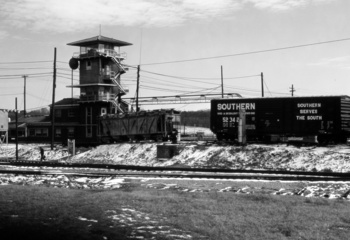
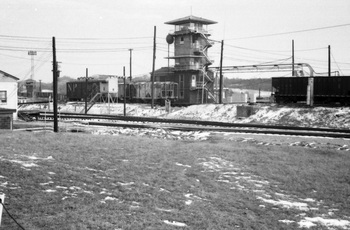
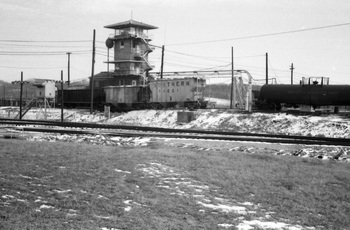
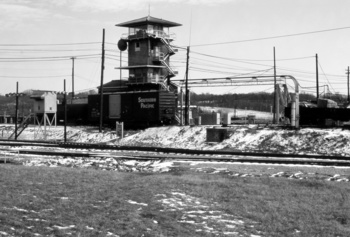
Archival data on the web provides the relieving opportunity even to the overseas enthusiasts like me in Japan these gloomy days. It’s the chance to explore the legacy of our hobby relatively rich in history: Railroad Model Craftsman magazine from 1933, or Trains magazine from 1940, for example.
If you search Magazine Index at trains.com, you may find the preceding projects or trips you are planning to carry out. Or, you may find a photo shot from the same angle you did last week at Railroad Picture Archives web site. I think these overlapped cases are not of being disappointing but of delighting: it’s the moment when the two meet transcending the time and space. Accordingly, I always respect the contributors and administrators of the site when finding a photo of the exact car I was looking for.
Such a relation between the consignor and the consignee is also called postal[1, 2]. Postcards may go astray which never happens at e-mails. However, fortunately, postcards will be delivered someday somewhere. That is to say, there may be a gap between the desires of the consignor and the consignee, but both the consignor and the consignee would be anyhow fulfilled. I think here is the true pleasure of questing for the archives, and our rich legacy of enthusiasm enables it. It may take time but we have plenty of it for the time being.
My photos above are showing freight cars and SOU facilities. I took these photos almost fifty years ago because the hump work was interesting for me at that time. But someone who is applying the decal on the model of the particular almost new Pullman-built 5277 cuft SOU boxcar, or someone who is scratch-building the unique MP covered hopper #702695, or someone researching Industrial Molasses Corp. read on the tank car today may appreciate the photo. If so, I’ll be glad I have posted the photos.
Here are some archival resources for my Paint Shop posts I’ve hardly mentioned before:
* Trains.com Magazine Index (index not only for Kalmbach magazines but for other 46 magazines);
* Railmodel Journal Magazine Archive (rich in articles on Incentive Per Diem boxcars of the ’70s);
* City of Vancouver Archives, Walter E. Frost fonds (rich in photos of boxcars found at Vancouver from the ’40s to the ’60s)
* search results for “boxcar photo slide” at ebay;
All photos were taken at Knoxville, TN in 1971.
[1] Derrida, Jaques, (1987) The Post Card, University of Chicago Press
[2] Azuma, Hiroki, (1998) Ontological, Postal, About Jacque Derrida, Shinchosha (Japanese only)
2020-05-01 09:00
コメント(0)
1974 – 75 Continental Telephone Company of Utah Telephone Directories [Column_Printed Matter]
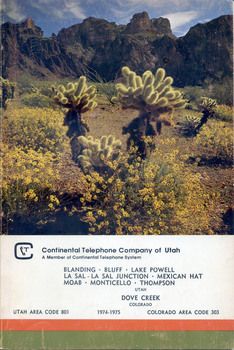 : cover
: coverMy recent buy at eBay is this vintage telephone directory. The purpose of the purchase was to research the last Cisco residents and businesses when the town was almost fading.
In 1974, previous to the printing of the directory, the Midland Telephone Company covering Cisco at that time merged with the Utah Telephone Company to form the Continental Telephone Company of Utah[1].
Unfortunately, the directory didn’t list any Cisco phone numbers: maybe they were dropped from the coverage during the merger. But several Thompson phone numbers are listed. They may add some details to my articles on Thompson structures.
[1] Jan. 17, 1974 Tremonton Leader;
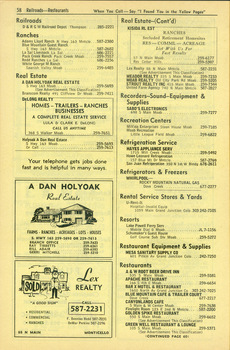 : yellow page for Railroads
: yellow page for Railroads 2020-07-24 09:00
コメント(0)
Fall and Winter 1939–40 Passenger Timetable [Column_Printed Matter]
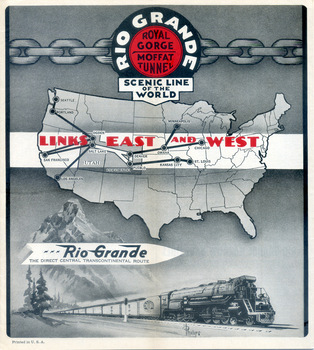 : front cover
: front coverAnother recent buy at eBay is this Fall and Winter 1939 Passenger Timetable issued from D&RGW: the first passenger timetable to sport the “flying” logo.
Compared the design to the passenger timetables issued previously and afterward, “DENVER & RIO GRANDE WESTERN RAILROAD” logotype using art-deco style font at the header in previous issues was basically switched to the new flying “Rio Grande” logo in this issue[1].
However, unfortunately, the flying logo at the header was made smaller at least in the 1951 issue, and disappeared from the body at least in the 1962 issue, preceding the 1966 approval of the “stacked” logo.
A little change in detail I found is the number read on the numberboard of the steam locomotive appears in the front cover: #3600 in the 1936 issue and #3700 in the 1939 issue. According to the roster, #3700 is an L-105 built by Baldwin in 1938: one of the latest locomotives at the time when this timetable was printed[2].
[1] Holmes, ND, November 15, 1936 Passenger Timetable, D&RGW Passenger Timetables, DRGW.net;
[2] 1952 photo of D&RGW #3700 by Otto Perry at Denver Public Library Digital Collections;
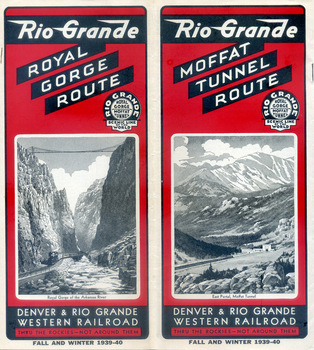 : back cover
: back cover2020-10-02 09:00
コメント(0)



